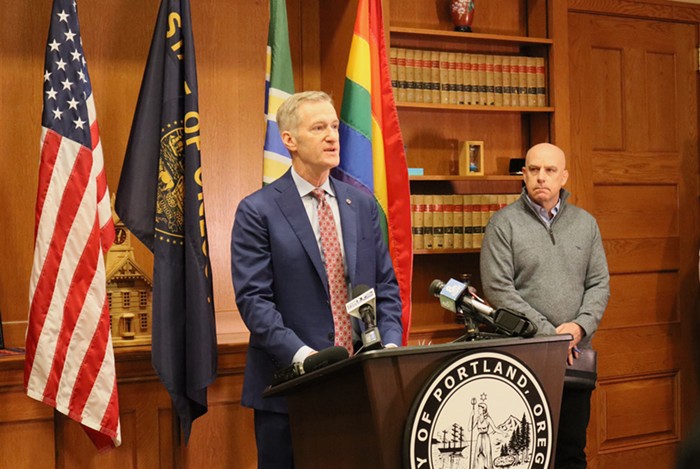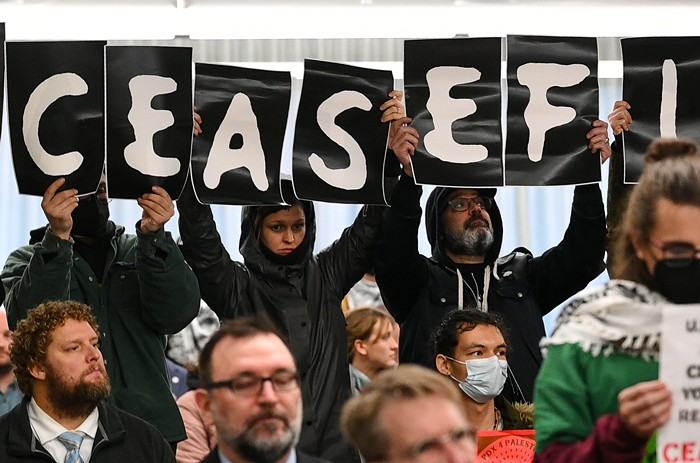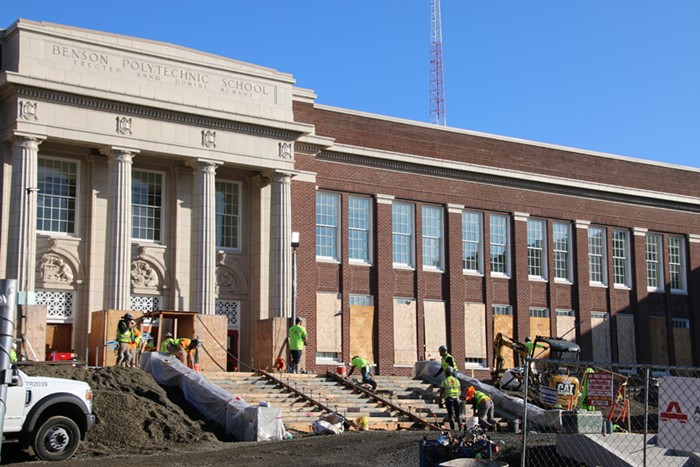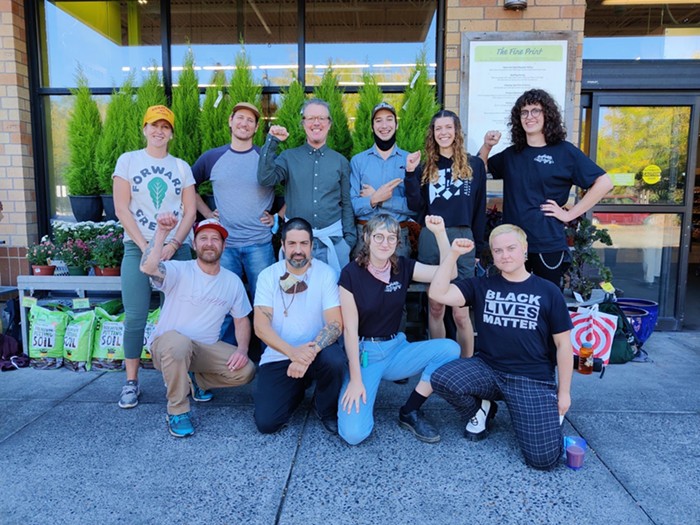THE HILTON GRAND BALLROOM is buzzing.
It's Sunday, April 11. Four hundred people have crowded into the downtown Portland ballroom, most are holding auction paddles. Some have brought their kids, others have brought their lawyers. All hope to snatch up a cheap condo in the John Ross, the South Waterfront luxury-living building that bills itself as "the shining example of Portland's commitment to sustainable living."
Portland's shining example is about to be sold to the highest bidder.
"Portland's first green neighborhood!" crows the auctioneer, who is wearing a red tie and navy blue jacket. "Green innovation and ideal location combine!"
Portland has invested $93 million and 10 years in developing the South Waterfront urban renewal area. The result is five shimmering towers that rise between the freeway and the river south of downtown. The John Ross. Atwater Place. The Meriwether. The Ardea. Riva on the Park.
The Atwater was the first to auction off units last fall, unloading unsold condos for cut rates in the midst of the recession. The John Ross staved off auction for longer. At the height of the condo craze in 2005, the John Ross pre-sold 80 percent of its units in six days. This winter, that number had dropped to 74 percent sold. To resuscitate the building, its owners have put 48 units on the auction block. This includes a fabulous penthouse, whose kitchen comes with a built-in wine fridge and whose 30th-story wrap-around patio seems like a place Bruce Wayne might host a soiree. Original price tag: $1.49 million.
The auction is a smart move, but a desperate one. The special tax breaks that promote development in South Waterfront are going to be around until at least 2020. By that time, the city estimates it will have spent $221 million in public money building the area.
The Grand Ballroom leaps into action as the auction begins. Men in navy blue coats bark at the crowd, paddles are raised, bidding wars ensue. The penthouse goes for $851,000. The winners are offered bacon-wrapped scallops and bruschetta while they sign the papers.
***
Weeks later, as dusk falls, I wander the streets of South Waterfront. All is quiet. In 1999, Portland Development Commission (PDC), city hall, and Oregon Health and Science University (OHSU) laid plans for South Waterfront, imagining it as a jobs district. Establishment of an urban renewal area, coupling public investment with tax breaks for developers, would create up to 10,000 jobs in Portland's newest, greenest neighborhood—or so promised the plan.
But 10 years in, it has created only 2,300 jobs and South Waterfront's dense condo buildings are ringed with retail space for lease. Empty storefronts are gaping abscesses at the feet of the glass and steel towers.
Residents and real estate agents deal with the emptiness in creative ways. Much of the coping seems to involve dogs. A lot of dogs. When they are out, most of the actual neighbors I see on the streets of South Waterfront are walking these dogs. There are pooper-scooper stations set up all around the area.
"Sometimes it feels like there are two dogs for every person," notes Jesse Braeoninger, the clerk at the Urbana Market, which stocks a mix of organic snacks and convenience store food. It was almost closing time. No one else was around and Braeoninger had already dumped out the water bowl the shop puts out for customers' pooches.
I count eight operating retail spaces in South Waterfront. Two of those retail outfits are doggie daycares/dog spas. That means dog-related pampering accounts for 25 percent of South Waterfront's retail.
I ask Braeoninger what it's like to work in the center of the city's jobs district. He doesn't understand what I'm talking about.
"It's like a ghost town or a black hole here," he says. He's young. He lives near Lloyd Center. The Urbana Market is a good gig he found on Craigslist. He sells a lot of beer, wine, and milk. Basics.
"Oh, and we sell a lot of lottery tickets. You should probably put that in your article," he adds. Maybe about 200 to 300 lottery tickets a day. Keno. Powerball. I leave.
Next door to Urbana Market, sushi place Le Hana is bustling. Thanks, perhaps, to its rather alarming but highly advertised special: dinner 50 percent off (with purchase of drink).
***
I walk between the tall buildings until I reach the desolate frontier south of Riva on the Park. The wind rustles through bioswales and the sun sets over OHSU. Not a soul is in sight. I half expect a tumbleweed of native grasses to blow across the wide desert of empty sidewalk.
The pavement ends abruptly after the Riva. It's a jarring break from the development's smooth, white stone to a gravel path running next to construction fencing. From 1910 through the 1960s, South Waterfront was home to industry. For the next 40 years it was mostly abandoned.
Out there past the new, shimmering towers is the unfinished "creative apartment-living complex" the Matisse, a loading dock, more construction yards, vacant brownfields, and the end of the streetcar line.
"If you are inspired about the art of living, then your inspiration lives at the Matisse," says the building's promotional materials.
I stand for a while at the end of the streetcar line, where the tracks loop back to downtown. I'm not sure where to go, so I stare at the finely etched glass wall facing the track, which is engraved with some history. Generations before there was urban renewal and eco-districts, South Waterfront was the Jewish part of town.
"Small homes huddled close to the main thoroughfares, cobblestone boulevards lined with delicatessens, bakeries, and shops filled with neighbors," reads the glass.
The blue lights of the Old Spaghetti Factory glare across the expanse of two parking lots. Six sapling trees huddle together near the streetcar stop, bound together with caution tape. It's getting cold. I hear footsteps and am afraid someone has come to rob me. I find it hard to be inspired about the art of living.
***
Across the street from the John Ross and the Riva on the Park is, yes, a park. The park is lovely, with small, sloping green hills and stone-paved paths. A locked chain-link fence surrounds it. Elizabeth Caruthers Park was supposed to open in July 2009, but it will open this summer, a year late.
And across from Elizabeth Caruthers Park, staring out at the luxury units of the John Ross and Atwater Place is a muddy gravel lot that was supposed to be 400 units of affordable housing. Construction workers for the surrounding condos use it as a parking lot.
The South Waterfront urban renewal area is supposed to have up to 788 units of affordable housing. As of yet, not a single unit has been built.
"The South Waterfront District is a diverse, inclusive riverfront neighborhood," reads the planning bureau's vision for South Waterfront in 2020, written in 2002.
That vision of South Waterfront has failed.
The city poured $16 million into planning Block 33 (the muddy parking lot) and negotiation building rights, but the deal fell through with the market crash. ["Broken Homes," News, March 4]. The city sold the property back to OHSU for a loss last month.
Plans are moving forward to build a different affordable housing complex, Block 49, but meanwhile housing advocates are quick to point out the stark contrast between the promise of a mixed-income neighborhood and the reality of the muddy pit that sits under the shadow of the tram. Homeless advocacy group Sisters of the Road rallied 20 people at Block 33 on Wednesday, March 31, with megaphones and posters reading, "If these units had been built, we'd be home now." Except for their rabble-housing and a television crew, the emerging neighborhood was eerily empty.
League of Women Voters member Debbie Aiona, who sat in on the urban renewal process from the beginning, says the city should have bought land for affordable housing and pushed condo developers to carve out land for greenways before the district became an urban renewal area.
"It would have been smart to get in place those things that are difficult to carry out, if they were going to be an important part of your plan," says Aiona.
***
But in some ways, our ghost town has met its goals.
When the urban renewal area was founded, South Waterfront consisted of abandoned, contaminated industrial land, a barge-building factory, and the world headquarters of the Old Spaghetti Factory. Humble beginnings.
From there, we have built 1,400 homes (though none of them affordable), a gorgeous aerial tram (though with money originally slated to build South Waterfront's streets and parks), and laid the infrastructure for Portland's downtown to expand. The neighborhood is linked to transit, and the condo towers are LEED-certified. For $93 million, it's a helluva lot better than it used to be.
Plus, PDC number-cruncher Faye Brown says that despite the bottom falling out of the real estate market, South Waterfront is financially on track to pay back the $62 million the city has borrowed from South Waterfront urban renewal funds to build the streetcar, the tram, the streets, and the parks. PDC estimated South Waterfront's central area would generate $5 million annually in tax increment financing by last year. It's actually created $7.2 million.
"It's easy to diss things in this financial climate, to say, 'You should have' and 'I told you so.' But this is a really important piece of property and it's still a work in progress," says local design critic and Portland Monthly Editor Randy Gragg, who penned outspoken columns in favor of establishing South Waterfront as an urban renewal area 10 years ago when he wrote for the Oregonian. Gragg doesn't like everything about what South Waterfront has become ("The buildings are just too damn fat."), but he does think it will pay off, in the long run, to build the fancy condos before low-income housing.
"It's easy for idealists to stand on the sidelines and criticize. But the numbers just didn't work at the time," says Gragg. "The development has to fund the development. Affordable housing does not create a tax base of any reasonable consequence."
Urban designer and architect George Crandall believes so strongly in the area that he sold his Northwest Portland home to snatch up a cut-rate condo at Atwater Place last year.
"I think it will be a model for how cities can become more sustainable and for how we can get infill on vacant land," says Crandall. "The neighborhood may not be what I want today, but my sense is within a few years it will be the place to be in Portland." Crandall concedes, though, that the push to bring retail to the condo canyon is stuck in a tail-chasing spiral. Retail needs people. People won't move somewhere that doesn't have retail.
"What South Waterfront really needs is a grocery store," agrees Tom Heinicke, a real estate agent who also runs insidery blog agent503.com. He says he wouldn't discourage someone from buying in South Waterfront, but the buyer would need to hold onto their new home for at least eight or 10 years to turn a real profit.
"There's too much public money going into it for it to fail," says Heinicke. "I know there are opinions out there that say it'll be a ghost town in 20 years. I don't agree. It's kind of a 'too big to fail' for Portland."
So maybe this is what progress feels like. Progress feels surprisingly empty.
But who needs a grocery store, anyway, when the John Ross' concierge service will do your grocery shopping for you? And your laundry. And feed your dog.



















